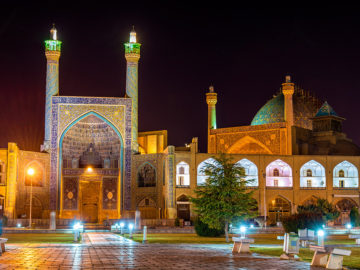
The foundation of the Khaju Bridge refers to an older bridge dating back to the Timurid Dynasty (1370-1507) but the current bridge was completed in about 1650 during Shah Abbas II, Safavid Dynasty (1501-1736) to link two major Isfahan’s neighborhoods on the shore of the Zayahdeh Rud River. In general, the bridge measures about 133 and 12 meters in length and width, respectively.
Of note is that during the Safavid Dynasty, the bridge was called Shah Bridge (King Bridge) and Baba Rokn ol Din, because of its location in a route to the Baba Rokn ol Din Tekieh (a religious place to commemorate the martyrdom of Imam Hossein, the third Shia Imam). The bridge had also been called Hasan Abad Bridge, the name of a nearby bridge, and Shiraz Bridge since passengers crossed this bridge on their way to Shiraz City. Finally, it was entitled Khaju following the name of its neighborhood.

The Khaju Bridge functioning also as a weir consists of two floors, 26 smaller and 21 larger water channels (on the ground floor), and two-sided parallel corridors with 23 arches (on the first floor). Notably, the channels of the bridge could be closed in order to raise water for irrigation of nearby lands.
The bridge also possesses two pavilions in the middle of eastern and western sides that were called Beygar Beygi. These structures also known as Shah Neshin were used by the king (Shah Abbas II) and his family as a recreational place to enjoy the view and also as a place where they watched sailing and swimming competitions.

Today, a mere stone bench has remained of the magnificent bench that the king used in these pavilions. There are also two stone lions at two ends of the bridge that is believed they represent Bakhtiari army and Isfahan’s resistance forces during the Safavid Dynasty.

